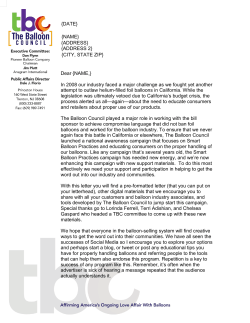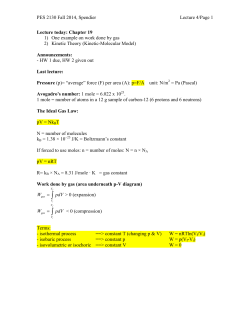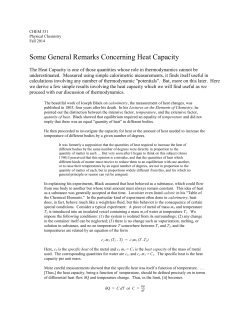
Chapter 5 QUIZ B Short Answer Name __________________________ 1.)
Name __________________________ Chapter 5 QUIZ B Short Answer 1.) Observations about real gases can be explained at the molecular level according to the kinetic molecular theory of gases and ideas about intermolecular forces. Explain how each of the following observations can be interpreted according to these concepts, including how the observation supports the correctness of these theories. (a) When a gas-filled balloon is cooled, it shrinks in volume; this occurs no matter what gas is originally placed in the balloon. (b) When the balloon described in (a) is cooled further, the volume does not become zero; rather, the gas becomes a liquid or solid. (c) When NH3 gas is introduced at one end of a long tube while HCl gas is introduced simultaneously at the other end, a ring of white ammonium chloride is observed to form in the tube after a few minutes. This ring is closer to the HCl end of the tube than the NH3 end. (d) A flag waves in the wind. 2.) Represented above are five identical balloons, each filled to the same volume at 25 C and 1.0 atmosphere of pressure with the pure gases indicated. (a) Which balloon contains the smallest mass of gas? Explain. (b) Compare the average kinetic energies of the gas molecules in the balloons. Explain. (c) Which balloon contains the gas that would be expected to deviate most from the behavior of an ideal gas? Explain. (d) Twelve hours after being filled, all the balloons have decreased in size. Predict which balloon will be the smallest. Explain your reasoning. Problem 3.) A student collected a sample of hydrogen gas by the displacement of water as shown by the diagram above. The relevant data are given in the following table. Volume of sample 45.00 mL Temperature 25 C Atmospheric Pressure 765 mm Hg EquilibriumVapor Pressure of H2O (25 C) 23.8 mm Hg (a) What is the name of the equipment used to collect and measure the volume of the gas? (b) Calculate the number of moles of hydrogen gas collected. (c) Calculate the number of molecules of water vapor in the sample of gas. (d) Calculate the ratio of the average speed of the hydrogen molecules to the average speed of the water vapor molecules in the sample. (d) Which of the two gases, H2 or H2O, deviates more from ideal behavior? Explain your answer. Answer #1: (a) CO2; according to Avogadro’s Hypothesis, they all contain the same number of particles, therefore, the heaviest molecule, CO2 (molar mass = 44), will have the greatest mass. (b) all the same; at the same temperature all gases have the same kinetic energy. (c) CO2; since they are all essentially non-polar, the largest intermolecular (London) force would be greatest in the molecule/atom with the largest number of electrons. (d) He; it has the smallest size and has the greatest particulate speed and, therefore, it’s the easiest to penetrate the wall and effuse. Answer #2: (a) Reducing the temperature of a gas reduces the average kinetic energy (or velocity) of the gas molecules. This would reduce the number (or frequency) of collisions of gas molecules with the surface of the balloon; [OR decrease the momentum change that occurs when the gas molecules strike the balloon surface] . In order to maintain a constant pressure vs the external pressure, the volume must decrease. (b) The molecules of the gas do have volume, when they are cooled sufficiently, the forces of attraction that exist between them cause them to liquefy or solidify. (c) The molecules of gas are in constant motion so the HCl and NH3 diffuse along the tube. Where they meet, NH4Cl(s) is formed. Since HCl has a higher molar mass, its velocity (average) is lower, therefore, it doesn’t diffuse as fast as the NH3. (d) The wind is moving molecules of air that are going mostly in one direction. Upon encountering a flag, they transfer some of their energy (momentum) to it and cause it to move (flap!). Answer #3: (a) PH2 = Patm - PH2O = (745 - 23.8) mm Hg = 721.2 mm Hg n = (PV)/(RT) = (721.2 mm Hg = 3.49 10-3 mol (b) nH O = (23.8 mm Hg molecules 2 90.0 mL)/(62400 mm Hg.mL/mol.K 90.0 mL)/(62400 mm Hg.mL/mol.K 298.15K) 298.15K) 6.022 1023 molecules/mol = 6.93 1019 (c) (massH2)(velocityH2)2 = (massH2O)(velocityH2O)2 2(vH )2 = 18(vH O)2 v2H / v2H O = 9; vH / vH O = 3 2 2 2 2 2 2 (d) H2O deviates more from ideal behavior: (i) greater number of electrons = greater van der Waal attration (ii) it is a polar molecule with strong polar attration (iii) it hydrogen bonds to other water molecules (iv) larger molecule and is slower at a given temp. and occupies more space.
© Copyright 2025





















